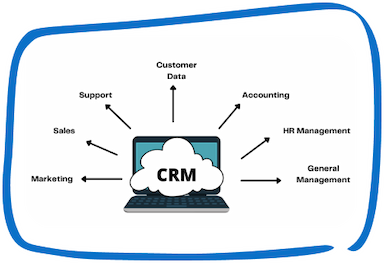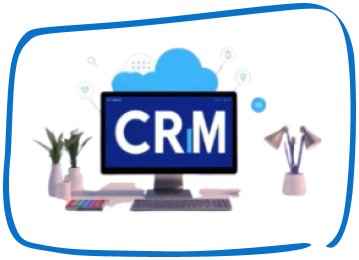Enterprise Resource Planning or ERP software integration takes extensive data from various business functions and store it in a centralized repository for streamlined accessibility. This approach empowers you to make well-informed, data-driven decisions for your business.
However, the flow of information into and out of an ERP system can often be laborious and time-intensive. In such cases, crucial business information might remain confined within specialized systems, accessible only to those intimately familiar with those systems. This phenomenon is commonly referred to as “data silos” and is known to impede business productivity significantly.
Nevertheless, there is an alternative. ERP integration eliminates the need for manual data transfer across all business applications. This guide aims to elucidate what successful ERP integration entails, why it can prove beneficial. We will also look at how you can seamlessly integrate your ERP system with other pivotal business applications.
What is ERP Software Integration
ERP integration entails the procedure of linking two or more separate business systems and enabling them to interact and share data. An ERP system is employed for overseeing a variety of business functions, such as Customer Relationship Management (CRM), Human Resources (HR), Financial Management, Supply Chain Management, and more. Nevertheless, in contemporary business operations, multiple software applications are utilized to manage distinct business processes. ERP integration facilitates the smooth transfer of information among various software applications utilized within an enterprise. Through the integration of an ERP system with other applications, organizations can readily access and exchange information, automate tasks, and attain a more comprehensive understanding of their overall operations.
Benefits of ERP Integration with Other Business Software
In this section, we will delve into the advantages of integrating ERP with other business software, including:
- Streamlined Processes. ERP integration reduces manual data entry and minimizes duplicated efforts, saving time and reducing errors.
- Increased Efficiency and Productivity. Automation and real-time data access boost efficiency and productivity.
- Better Data Quality and Accuracy. ERP integration eliminates data silos, providing a single source of truth for improved data quality.
- Enhanced Decision-Making. Access to comprehensive and accurate data aids informed decision-making.
- Cost Reductions. Manual processes are reduced, lowering costs and minimizing error risks.
- Improved Customer Experience. Integrating ERP with CRM systems enhances customer service through a holistic view of customer data.
- Competitive Advantage. Leveraging ERP integration improves operations, delivering a competitive edge and better outcomes.
Tips for a Successful ERP software Integration
Clearly Define Your Requirements:
Before commencing the integration process, it is crucial to thoroughly understand your specific needs. This entails identifying the applications you intend to integrate with your ERP system. It basically determines the data that the business person needs to exchange between these systems, and establishing the frequency of data transfers. Additionally, it’s essential to pinpoint the operational processes that integration will impact on.
Select the Appropriate Integration Approach:
There are several integration methods available, each with its own merits. Your options include point-to-point integration, middleware integration, and hybrid integration. Point-to-point integration involves a direct connection between two applications. Middleware integration relies on middleware software to connect multiple applications. Hybrid integration combines elements of both point-to-point and middleware integration. Overall, the choice of integration approach should align with your integration requirements, budget constraints, and technical capabilities.
Establish Data Mapping:
Data mapping involves the precise delineation of how data from one system corresponds to data in another system. This encompasses the identification of the specific data elements subject to mapping, the formulation of mapping rules, and any necessary data transformations. Data mapping guarantees the accurate interpretation and utilization of data within the receiving system.
Standardize Data Formats:
In order to seamlessly integrate your ERP software with other business applications, it is imperative to standardize data formats. This process entails the specification of data structure, data types, and data elements to be utilized in the integration workflow. Also, standardizing data formats ensures the reliable and consistent transfer of data between systems.
Utilize API-Based Integration:
Application programming interfaces (APIs) stand as a widely adopted method for integrating ERP systems with other business applications. APIs provide a standardized interface for accessing and exchanging data between applications. Leveraging API-based integration not only facilitates rapid and secure system integration but also allows for easy scalability as your business expands.
Ensure Data Security:
The integration of your ERP system with other applications necessitates the transfer of sensitive business data between these systems. Hence, prioritizing data security is imperative. It is crucial to confirm that your chosen integration solution incorporates robust data protection measures, including encryption, authentication protocols, and access controls. These measures are vital for safeguarding against data breaches, unauthorized access, and other potential threats.
Implement Real-Time Integration:
When integrating your ERP system with other business applications, real-time integration emerges as a pivotal requirement. This involves business people promptly transfering data between systems in real-time or very close to real-time. Real-time integration provides timely and precise data for informed decision-making, guaranteeing data consistency across all systems.
Conduct Thorough Testing of Your Integration Solution:
Prior to deploying your integration solution, it is imperative to subject it to comprehensive testing. Rigorous testing is essential for identifying and resolving any errors or issues before they can impact your business operations. It is vital to assess your integration solution using real data and scenarios to confirm its ability to handle various data types and business processes.
Continuously Monitor and Test the Integration:
Following the execution of the integration, ongoing oversight and evaluation of its functionality are imperative. This involves setting up monitoring tools to track the data transfer process. It also encompasses the identification and resolution of any errors or issues that may arise during the integration process. Additionally, business owners can conduct periodic testing to ensure the integration is operating correctly. This proactive approach allows for the early detection and mitigation of potential problems before they escalate into critical issues.
Provide Employee Training:
Employee training plays a pivotal role in the successful integration of your ERP system with other business applications. Inadequate training can lead to employee difficulties in proficiently utilizing new systems, resulting in decreased productivity and increased error rates. Therefore, ensuring comprehensive training for your staff is crucial to achieving integration success.
Integrating ERP Systems with Penieltech
Penieltech is at the forefront of the SaaS market category and remains a trailblazer in its advancement. Our primary goal is to empower businesses to attain their optimal results by implementing intelligent integration and automation. This connectivity commences with the essential step of ensuring that you integrate Enterprise Resource Planning (ERP) systems seamlessly across the entire spectrum of a business’s operations.
Speak with Our Team!
4.9 Stars
1k+ reviews on






